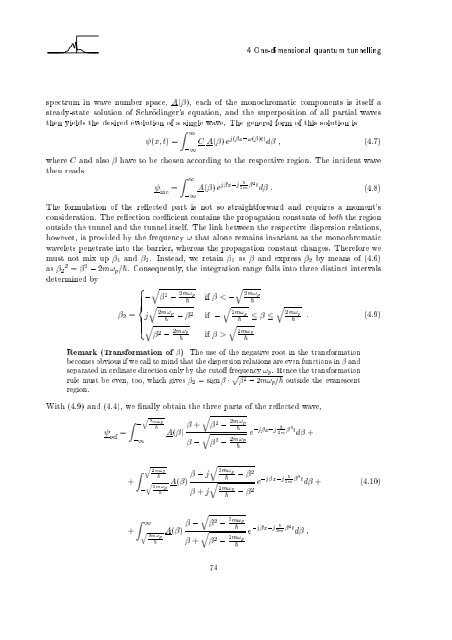Wave Propagation in Linear Media | re-examined
Wave Propagation in Linear Media | re-examined
Wave Propagation in Linear Media | re-examined
Create successful ePaper yourself
Turn your PDF publications into a flip-book with our unique Google optimized e-Paper software.
4 One-dimensional quantum tunnell<strong>in</strong>g<br />
spectrum <strong>in</strong> wave number space, A( ), each of the monochromatic components is itself a<br />
steady-state solution of Schrod<strong>in</strong>ger's equation, and the superposition of all partial waves<br />
then yields the desi<strong>re</strong>d evolution of a s<strong>in</strong>gle wave. The general form of this solution is<br />
(x; t) =<br />
Z 1<br />
C A( ) e<br />
,1<br />
j( x,!( )t) d ; (4.7)<br />
whe<strong>re</strong> C and also have tobechosen accord<strong>in</strong>g to the <strong>re</strong>spective <strong>re</strong>gion. The <strong>in</strong>cident wave<br />
then <strong>re</strong>ads<br />
<strong>in</strong>c =<br />
Z 1<br />
,1<br />
j x,j<br />
~<br />
A( ) e 2m 2t d : (4.8)<br />
The formulation of the <strong>re</strong> ected part is not so straightforward and <strong>re</strong>qui<strong>re</strong>s a moment's<br />
consideration. The <strong>re</strong> ection coe cient conta<strong>in</strong>s the propagation constants of both the <strong>re</strong>gion<br />
outside the tunnel and the tunnel itself. The l<strong>in</strong>k between the <strong>re</strong>spective dispersion <strong>re</strong>lations,<br />
however, is provided by the f<strong>re</strong>quency ! that alone <strong>re</strong>ma<strong>in</strong>s <strong>in</strong>variant as the monochromatic<br />
wavelets penetrate <strong>in</strong>to the barrier, whe<strong>re</strong>as the propagation constant changes. The<strong>re</strong>fo<strong>re</strong> we<br />
must not mix up 1 and 2. Instead, we <strong>re</strong>ta<strong>in</strong> 1 as and exp<strong>re</strong>ss 2 by means of (4.6)<br />
as 2 2 = 2 , 2m!p=~. Consequently, the <strong>in</strong>tegration range falls <strong>in</strong>to th<strong>re</strong>e dist<strong>in</strong>ct <strong>in</strong>tervals<br />
determ<strong>in</strong>ed by<br />
2 =<br />
8<br />
><<br />
>:<br />
,<br />
q 2 , 2m!p<br />
q 2m!p<br />
~ if <br />
~<br />
q<br />
2m!p<br />
~<br />
q<br />
2m!p<br />
~<br />
q<br />
2m!p<br />
~<br />
q 2m!p<br />
~<br />
: (4.9)<br />
Remark (Transformation of ) The use of the negative root<strong>in</strong>thetransformation<br />
becomes obvious if we call to m<strong>in</strong>d that the dispersion <strong>re</strong>lations a<strong>re</strong> even functions <strong>in</strong> and<br />
separated <strong>in</strong> ord<strong>in</strong>ate di<strong>re</strong>ction only by the cuto f<strong>re</strong>quency !p. Hence the transformation<br />
rule must be even, too, which gives 2 = sign p 2 , 2m!p=~ outside the evanescent<br />
<strong>re</strong>gion.<br />
With (4.9) and (4.4), we nally obta<strong>in</strong> the th<strong>re</strong>e parts of the <strong>re</strong> ected wave,<br />
<strong>re</strong>f =<br />
Z ,<br />
+<br />
,1<br />
q 2m!p<br />
~<br />
Z q 2m!p<br />
~<br />
q 2m!p<br />
, ~<br />
Z 1<br />
+ q 2m!p<br />
~<br />
A( ) +<br />
A( )<br />
,<br />
q<br />
2 2m!p<br />
, ~ q<br />
2 2m!p<br />
, ~<br />
q<br />
2m!p<br />
, j ~ , 2<br />
q<br />
2m!p<br />
+ j ~ , 2<br />
A( ) ,<br />
q<br />
2 2m!p<br />
, ~<br />
+<br />
q<br />
2 2m!p<br />
, ~<br />
74<br />
,j x,j<br />
~<br />
e 2m 2t d +<br />
,j x,j<br />
~<br />
e 2m 2t d +<br />
,j x,j<br />
~<br />
e 2m 2t d :<br />
(4.10)












